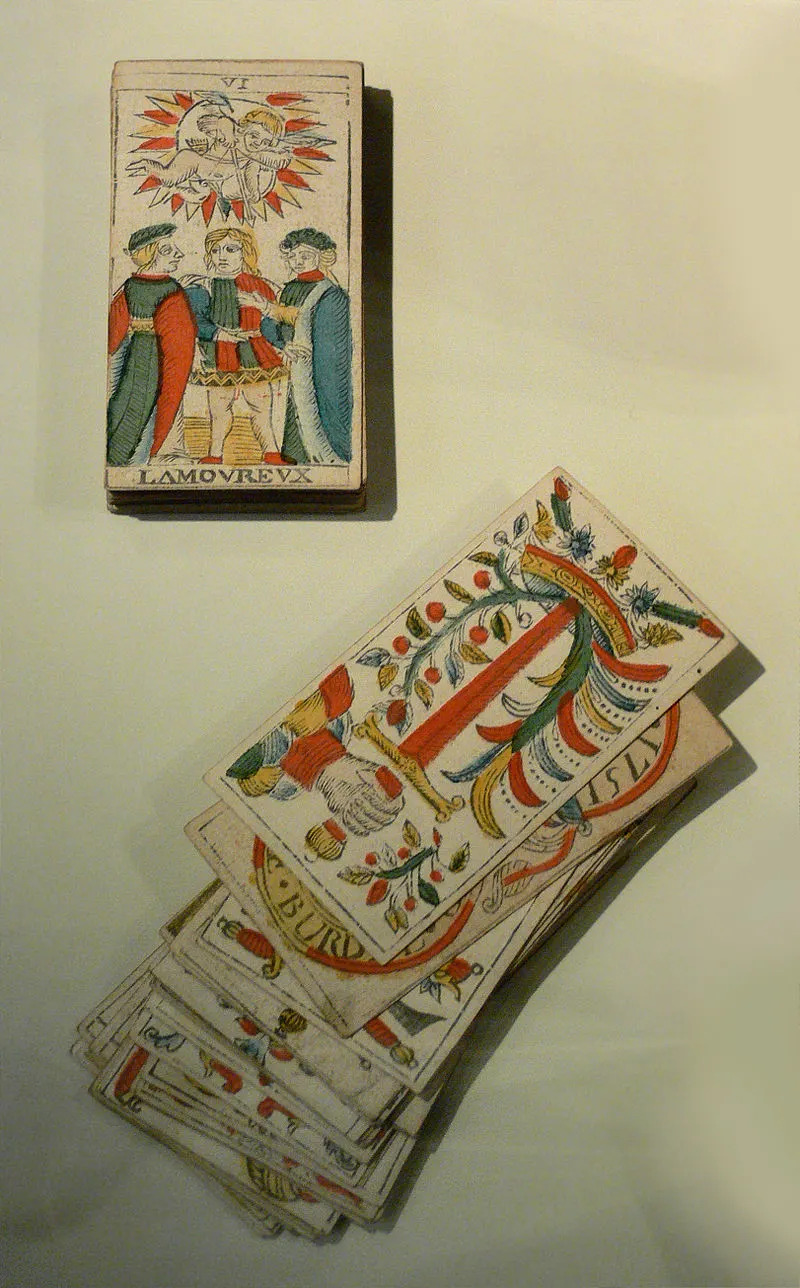Tarot: A Glance at the Historic Origins of A Misunderstood Practice
Lilith Eden
Lilith is rather attuned to her witchy side and regularly binges knowledge on all things witchcraft.

-Ancient playing cards from the Middle East region.
The Tarot's Historical Origins
As with most historical origins, the creation of tarot is not the easiest to pinpoint; all signs indicate that it first appeared around the fifteenth century, but of course, it could have existed long before then. But first, we have to backtrack even further, because long before there was tarot, there were playing cards, assumed to have been invented by the ancient Chinese. I mean, they invented paper, which is a must-have ingredient for said cards, so the logic checks out.
The practice of card playing was then carried east along trade routes, where it landed in Arab countries, which adopted and popularized it throughout the Middle East. Evidence of playing cards from 14th century Egypt portray an undeniable similarity with modern playing cards. Towards the close of the 1300s, Arabs arrived in Spain, and the cards, which seemed to have undergone some form of cultural adjustments with each country in which they were integrated, were tweaked a bit further. Spanish artisans, for instance, added a fifth trump suit ( a trump suit being one that "outranks" the other suits), to the four standard Arab-inspired suits. This created a new deck, deemed tarrochi, from which the word tarot may have derived.
From Card Playing to Divining
It was in the middle of 15th century Spain that Filippo Maria Visconti, Duke of Milan, proved unwilling to miss an opportunity to flex his wealth; he commissioned several decks of cards, which would later come to be known as the Visconti-Sforza tarot. These remain the oldest surviving tarot cards, the impact of which is still evidenced in the numbering, visual make-up, and interpretation of modern decks. It is unclear if tarot was already serving as a tool for divination then, but by the 1700s, card readers in northern Italy had developed a system for divining, which then spread to France, where the practice became voguish across the entire country.

-Tarot de Marseille
Once tarot was trending in France, Marseille served as the prime producer of tarot cards. Humbly, this city attributed its name to the standard pattern for tarot decks that we divine darlings still use today: the Tarot of Marseille. Naturally, deck variations, such as the early 1900s Rider-Waite-Smith Tarot, appeared. In this, perhaps the most popular (at least in the English-speaking world) version,the patterned decks of the Marseille tarot were illustrated with easily comprehensible scenes and characters, thereby allowing the masses greater access to tarot reading.
The Tarot Deck
Here's a basic overview of the 78-card deck: there are 22 major arcana cards ("arcana" means secret or mystery, by the way), 40 minor arcana number, or pip, cards, and 16 court -or face- cards. The major arcana includes cards such as The Fool, The World, and The Tower. The other 56 cards, the minor arcana, consist of four suits, generally referred to as wands, cups, swords, and pentacles, although alternate -yet still related- terms may be used. "Wands", for instance, may also be referred to as "batons" or "staves"; "pentacles" may be referenced as "coins" or "disks". Of those aforementioned 56 cards, 16 are designated as court, or royalty, cards that depict kings, queens, knights, and pages.
From the Divine to the Practical
Dispell that dated notion of some wispy dame clad in crystals and drenched in rose water muttering sweet nothings about your future over a smattering of tarot cards in some seedy, heavily perfumed parlor. Beyond the versatility of tarot in divining, it can be used for, well, more mundane purposes.
While it was a hype instrument for predicting the future over the past centuries, it is now a quasi multi-purpose tool. Some may draw a card and focus on the depicted image while meditating. Others will pull a card while pondering a conundrum to find clarity on a particular issue. It is even used as a projective technique in psychotherapy.
I forewarned that I couldn't possibly give a comprehensive history on the tarot, nor an extensive how-to guide; however, there are some fabulous books and websites out there if you decide to wade further into the water with which you just wet your feet! Go research some more, be ye a witchy or a practical soul.
Some Final Tarot Tid-bits
- The Celtic Cross is one of the most common tarot spreads, offering to answer a question or give an overview of life as it is at that moment.
- When a card is pulled and appears upside-down, this is known as a reversed card. A reversal may suggest that your energy is closed off, that you are resisting something, that a turning-point is coming,and many other interpretations.
- Tarot can be used in conjunction with other divinity tools, like rune stones or the classic crystal ball we so often peep in a Hollywoodized fortune-telling scene.
- Not psychic? No problem. With some studying and intuition honing, anyone who has the honest intention of reading cards is able to do so, hence it becoming such a popular self-care tool.
- If your tarot spread includes a card like the Devil or Death, images that naturally invoke a smidge of unease in most folks, this doesn't indicate doom. There are no good cards or bad cards; instead, these cards can indicate many things, like making you aware of negative patterns that are limiting your potential or that a time of spiritual transformation is fast approaching.
Mad Respect to the Reference Material
Reach out to the Author*

